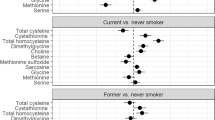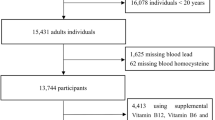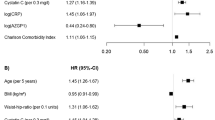Abstract
Background/Objectives:
This study aimed to investigate whether higher homocysteine and lower vitamin B12 concentrations increase the risk of future nursing home (NH) admission and all-cause mortality in independently living older persons.
Subjects/Methods:
In total, 1117 independently living participants (mean age=75.1, s.d.=6.4) were included in this prospective sub-study of the Longitudinal Aging Study Amsterdam. EDTA plasma samples, collected in 1995–1996, were analysed for total homocysteine (μmol/l). Time to NH admission was assessed using a follow-up until 2002–2003. In addition, we studied mortality until 1 June 2007. Cox proportional hazards models were used to examine the association between homocysteine in quartiles and risk of NH admission and mortality.
Results:
During follow-up, 126 persons (11.3%) were admitted to NHs, and 513 persons (45.9%) deceased. In men, no significant associations were observed. In women, after adjustment for confounding, the highest quartile of homocysteine was associated with a significantly higher risk of NH admission compared with the first quartile (hazard ratio (HR)=2.97, 95% confidence interval (CI)=1.36–6.49). Both women in the third and the fourth quartile of homocysteine had a significantly higher mortality risk (HR=1.70, 95% CI=1.08–2.65 and HR=1.91, 95% CI=1.22–3.00, respectively) compared with the first quartile. Vitamin B12 was not related to an increased risk of NH admission and mortality.
Conclusions:
Elevated plasma homocysteine is associated with an increased risk of NH admission and mortality in older women, but not in older men.
This is a preview of subscription content, access via your institution
Access options
Subscribe to this journal
Receive 12 print issues and online access
$259.00 per year
only $21.58 per issue
Buy this article
- Purchase on Springer Link
- Instant access to full article PDF
Prices may be subject to local taxes which are calculated during checkout


Similar content being viewed by others
References
Antoniades C, Antonopoulos AS, Tousoulis D, Marinou K, Stefanadis C (2009). Homocysteine and coronary atherosclerosis: from folate fortification to the recent clinical trials. Eur Heart J 30, 6–15.
Bartali B, Semba RD, Frongillo EA, Varadhan R, Ricks MO, Blaum CS et al. (2006). Low micronutrient levels as predictor of incident disability in older women. Arch Intern Med 27, 2335–2340.
Bonaa KH, Njolstad I, Ueland PM, Schirmer H, Tverdal A, Steigen T et al. (2006). Homocysteine lowering and cardiovascular events after acute myocardial infarction. N Engl J Med 354, 1578–1588.
Bostom AG, Silbershatz H, Rosenberg IH, Selhub J, D'Agostino RB, Wolf PA et al. (1999). Nonfasting plasma total homocysteine levels and all-cause and cardiovascular disease mortality in elderly Framingham men and women. Arch Intern Med 159, 1077–1080.
Dangour AD, Breeze E, Clarke R, Shetty PS, Uauy R, Fletcher AE (2008). Plasma homocysteine, but not folate or vitamin B-12, predicts mortality in older people in the United Kingdom. J Nutr 138, 1121–1128.
de Bree A, van der Put NMJ, Mennen LI, Verschuren WM, Blom HJ, Galan P et al. (2005). Prevalences of hyperhomocysteinemia, unfavorable cholesterol profile and hypertension in European populations. Eur J Clin 59, 480–488.
de Lau LM, Smith AD, Refsum H, Johnston C, Breteler MM (2009). Plasma vitamin B12 status and cerebral white-matter lesions. J Neurol Neurosurg Psychiatry 80, 149–157.
Dhonukshe-Rutten R, Pluijm SMF, de Groot LCPGM, Lips P, Smit JH, van Staveren WA (2005). Homocysteine and vitamin B12 status relate to bone turnover markers, broadband ultrasound attenuation, and fractures in healthy elderly people. J Bone Miner Res 20, 921–929.
Durga J, van Boxtel MPJ, Schouten EG, Kok FJ, Jolles J, Katan MB et al. (2007). Effect of 3- year folic acid supplementation on cognitive function in older adults in the FACIT trial: a randomised, double blind, controlled trial. Lancet 369, 208–216.
Eussen SJ, de Groot LC, Joosten LW, Bloo RJ, Clarke R, Ueland PM et al. (2006). Effect of oral vitamin B-12 with or without folic acid on cognitive function in older people with mild vitamin B-12 deficiency: a randomized, placebo-controlled trial. Am J Clin Nutr 84, 361–370.
Eussen SJPM, de Groot LCPG, Clarke R, Schneede J, Ueland PM, Hoefnagels WH et al. (2005). Oral cyanocobalamin supplementation in older people with vitamin B12 deficiency: a dose-finding trial. Arch Intern Med 165, 1167–1172.
Garretsen HFL (1983). Probleemdrinken, Prevalentiebepaling, Beinvloedende Factoren en Preventiemogelijkheden, Theoretische Overwegingen en Onderzoek in Rotterdam. Swets & Zeitlinger: Lisse, Dutch.
Haan MN, Miller JW, Aiello AE, Whitmer RA, Jagust WJ, Mungas DM et al. (2007). Homocysteine, B vitamins, and the incidence of dementia and cognitive impairment: results from the Sacramento Area Latino Study on Aging. Am J Clin Nutr 85, 511–517.
Holmbeck GN (1997). Toward terminological, conceptual, and statistical clarity in the study of mediators and moderators: examples from the child-clinical and pediatric psychology literatures. J Consult Clin Psychol 65, 599–610.
Kado DM, Bucur A, Selhub J, Rowe JW, Seeman T (2002). Homocysteine levels and decline in physical function: MacArthur Studies of Successful Aging. Am J Med 113, 537–542.
Kark JD, Selhub J, Adler B, Gofin J, Abramson JH, Friedman G et al. (1999). Nonfasting plasma total homocysteine level and mortality in middle-aged and elderly men and women in Jerusalem. Ann Intern Med 131, 321–330.
Kuo HK, Liao KC, Leveille SG, Bean JF, Yen C-J, Chen J-H et al. (2007). Relationship of homocysteine levels to quadriceps strength, gait speed, and late-life disability in older adults. J Gerontol A Biol Sci Med Sci 62, 434–439.
Lonn E, Yusuf S, Arnold MJ, Sheridan P, Pogue J, Micks M et al. (2006). Homocysteine lowering with folic acid and B vitamins in vascular disease. N Engl J Med 354, 1567–1577.
Luchsinger JA, Tang MX, Shea S, Miller J, Green R, Mayeux R (2004). Plasma homocysteine levels and risk of Alzheimer disease. Neurology 62, 1972–1976.
Manolescu BN, Oprea E, Farcasanu IC, Berteanu M, Cercasoc C (2010). Homocysteine and vitamin therapy in stroke prevention and treatment: a review. Acta Biochim Pol 57, 467–477.
Marengoni A, Cossi S, De Martinis M, Calabrese PA, Orini S, Grassi V (2004). Homocysteine and disability in hospitalized geriatric patients. Metabolism 53, 1016–1020.
Matteini AM, Walston JD, Fallin MD, Bandeen-Roche K, Kao WH, Semba RD et al. (2008). Markers of B-vitamin deficiency and frailty in older women. J Nutr Health Aging 12, 303–308.
McLean RR, Jacques PF, Selhub J, Fredman L, Tucker KL, Samelson EJ et al. (2008). Plasma B vitamins, homocysteine, and their relation with bone loss and hip fracture in elderly men and women. J Clin Endocrinol Metab 93, 2206–2212.
McMahon JA, Green TJ, Skeaff CM, Knight RG, Mann JI, Williams SM (2006). A controlled trial of homocysteine lowering and cognitive performance. N Engl J Med 354, 2764–2772.
Michelon E, Blaum C, Semba RD, Xue QL, Ricks MO, Fried LP (2006). Vitamin and carotenoid status in older women: associations with the frailty syndrome. J Gerontol A Biol Sci Med Sci 61, 600–607.
Mooijaart SP, Gussekloo J, Frolich M, Jolles J, Stott DJ, Westendorp RG et al. (2005). Homocysteine, vitamin B-12, and folic acid and the risk of cognitive decline in old age: the Leiden 85-Plus study. Am J Clin Nutr 82, 866–871.
Nilsson K, Gustafson L, Hultberg B (2009). Association between plasma homocysteine levels and mortality in elderly patients with mental illness. Dement Geriatr Cogn Disord 27, 579–583.
Nygard O, Nordrehaug JE, Refsum H, Ueland PM, Farstad M, Wollset SE (1997). Plasma homocysteine levels and mortality in patients with coronary artery disease. N Engl J Med 337, 230–236.
Rolita L, Holtzer R, Wang C, Lipton RB, Derby CA, Verghese J (2010). Homocysteine and mobility in older adults. J Am Geriatr Soc 58, 545–550.
Schalk BWM, Visser M, Bremmer MA, Penninx BX, Bouter LM, Deeg DJ (2006). Change of serum albumin and risk of cardiovascular disease and all-cause mortality: Longitudinal Aging Study Amsterdam. Am J Epidemiol 164, 969–977.
Semba RD, Bartali B, Zhou J, Blaum C, Ko CW, Fried LP (2006). Low serum micronutrient concentrations predict frailty among older women living in the community. J Gerontol A Biol Sci Med Sci 61, 594–599.
Seshadri S, Beiser A, Selhub J, Jacques PF, Rosenberg IH, D'Agostino RB et al. (2002). Plasma homocysteine as a risk factor for dementia and Alzheimer's disease. N Engl J Med 346, 476–483.
Shishehbor MH, Oliveira LPJ, Lauer MS, Sprecher DL, Wolski K, Cho L et al. (2008). Emerging cardiovascular risk factors that account for a significant portion of attributable mortality risk in chronic kidney disease. Am J Cardiol 101, 1741–1746.
Smith AD, Refsum H (2009). Vitamin B-12 and cognition in the elderly. Am J Clin Nutr 89, 707S–711S.
Smith JH, de Vries MZ (1994). Procedures and results of the field work. In: Deeg DJH, Westendrop- de Serriere M (eds). Autonomy and Well-Being in the Aging Population I: Report from the Longitudinal Aging Study Amsterdam. VU University Press: Amsterdam, pp 7–13.
Soumare A, Elbaz A, Ducros V, Tavernier B, Alpérovitch A, Tzourio C et al. (2006). Cross-sectional association between homocysteine and motor function in the elderly. Neurology 67, 985–990.
Stel VS, Smit JH, Pluijm SMF, Visser M, Deeg DJ, Lips P (2004). Comparison of the LASA Physical Activity Questionnaire with a 7-day diary and pedometer. J Clin Epidemiol 57, 252–258.
Tombaugh TN, McIntyre NJ (1992). The mini-mental state examination: a comprehensive review. J Am Geriatr Soc 40, 922–935.
Toole JF, Malinow MR, Chambless LE, Spence JD, Pettigrew LC, Howard VJ et al. (2004). Lowering homocysteine in patients with ischemic stroke to prevent recurrent stroke, myocardial infarction, and death: the Vitamin Intervention for Stroke Prevention (VISP) randomized controlled trial. JAMA 291, 565–575.
van Meurs JBJ, Dhonukshe-Rutten RAM, Pluijm SMF, van de Klift M, de Jonge R, Lindemans J et al. (2004). Homocysteine levels and the risk of osteoporotic fracture. N Engl J Med 350, 2033–2041.
van Oort FVA, Melse-Boonstra A, Brouwer IA, Clarke R, West CE, Katan MB et al. (2003). Folic acid and reduction of plasma homocysteine concentrations in older adults: a dose-response study. Am J Clin Nutr 77, 1318–1323.
Visser M, Deeg DJH, Puts MTE, Seidell JC, Lips P (2006). Low serum concentrations of 25-hydroxyvitamin D in older persons and the risk of nursing home admission. Am J Clin Nutr 84, 616–622.
Zeitlin A, Frishman WH, Chang CJ (1997). The association of vitamin b 12 and folate blood levels and mortality and cardiovascular morbidity incidence in the old old: the Bronx aging study. Am J Ther 4, 275–281.
Acknowledgements
This study is based on data collected in the context of the Longitudinal Aging Study Amsterdam (LASA), which is largely funded by the Ministry of Health, Welfare and Sports of the Netherlands.
Author information
Authors and Affiliations
Corresponding author
Ethics declarations
Competing interests
The authors declare no conflict of interest.
Rights and permissions
About this article
Cite this article
Swart, K., van Schoor, N., Blom, H. et al. Homocysteine and the risk of nursing home admission and mortality in older persons. Eur J Clin Nutr 66, 188–195 (2012). https://doi.org/10.1038/ejcn.2011.186
Received:
Revised:
Accepted:
Published:
Issue Date:
DOI: https://doi.org/10.1038/ejcn.2011.186
Keywords
This article is cited by
-
Associations of total homocysteine and kidney function with all-cause and cause-specific mortality in hypertensive patients: a mediation and joint analysis
Hypertension Research (2024)
-
Association between serum vitamin B12 and risk of all-cause mortality in elderly adults: a prospective cohort study
BMC Geriatrics (2021)
-
Association between Homocysteine Levels and All-cause Mortality: A Dose-Response Meta-Analysis of Prospective Studies
Scientific Reports (2017)
-
The Longitudinal Aging Study Amsterdam: cohort update 2016 and major findings
European Journal of Epidemiology (2016)
-
Elevated homocysteine levels are associated with low muscle strength and functional limitations in older persons
The Journal of nutrition, health and aging (2013)



